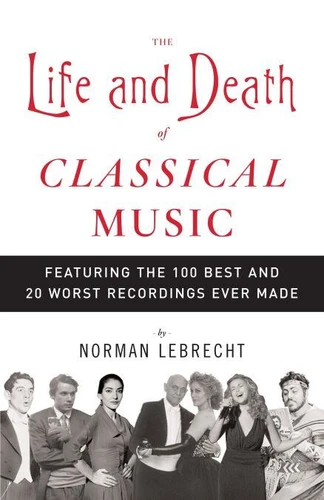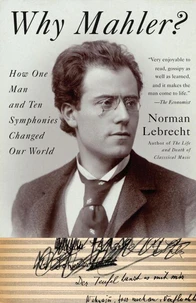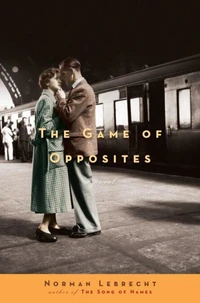The Life and Death of Classical Music. Featuring the 100 Best and 20 Worst Recordings Ever Made
Par :Formats :
Disponible dans votre compte client Decitre ou Furet du Nord dès validation de votre commande. Le format ePub protégé est :
- Compatible avec une lecture sur My Vivlio (smartphone, tablette, ordinateur)
- Compatible avec une lecture sur liseuses Vivlio
- Pour les liseuses autres que Vivlio, vous devez utiliser le logiciel Adobe Digital Edition. Non compatible avec la lecture sur les liseuses Kindle, Remarkable et Sony
- Non compatible avec un achat hors France métropolitaine
 , qui est-ce ?
, qui est-ce ?Notre partenaire de plateforme de lecture numérique où vous retrouverez l'ensemble de vos ebooks gratuitement
Pour en savoir plus sur nos ebooks, consultez notre aide en ligne ici
- Nombre de pages352
- FormatePub
- ISBN978-0-307-48746-9
- EAN9780307487469
- Date de parution18/12/2008
- Protection num.Adobe DRM
- Taille3 Mo
- Infos supplémentairesepub
- ÉditeurAnchor
Résumé
In this compulsively readable, fascinating, and provocative guide to classical music, Norman Lebrecht, one of the world's most widely read cultural commentators tells the story of the rise of the classical recording industry from Caruso's first notes to the heyday of Bernstein, Glenn Gould, Callas, and von Karajan. Lebrecht compellingly demonstrates that classical recording has reached its end point-but this is not simply an expos? of decline and fall.
It is, for the first time, the full story of a minor art form, analyzing the cultural revolution wrought by Schnabel, Toscanini, Callas, Rattle, the Three Tenors, and Charlotte Church. It is the story of how stars were made and broken by the record business; how a war criminal conspired with a concentration-camp victim to create a record empire; and how advancing technology, boardroom wars, public credulity and unscrupulous exploitation shaped the musical backdrop to our modern lives.
The book ends with a suitable shrine to classical recording: the author's critical selection of the 100 most important recordings-and the 20 most appalling. Filled with memorable incidents and unforgettable personalities-from Goddard Lieberson, legendary head of CBS Masterworks who signed his letters as God; to Georg Solti, who turned the Chicago Symphony into " the loudest symphony on earth"-this is at once the captivating story of the life and death of classical recording and an opinioned, insider's guide to appreciating the genre, now and for years to come.
It is, for the first time, the full story of a minor art form, analyzing the cultural revolution wrought by Schnabel, Toscanini, Callas, Rattle, the Three Tenors, and Charlotte Church. It is the story of how stars were made and broken by the record business; how a war criminal conspired with a concentration-camp victim to create a record empire; and how advancing technology, boardroom wars, public credulity and unscrupulous exploitation shaped the musical backdrop to our modern lives.
The book ends with a suitable shrine to classical recording: the author's critical selection of the 100 most important recordings-and the 20 most appalling. Filled with memorable incidents and unforgettable personalities-from Goddard Lieberson, legendary head of CBS Masterworks who signed his letters as God; to Georg Solti, who turned the Chicago Symphony into " the loudest symphony on earth"-this is at once the captivating story of the life and death of classical recording and an opinioned, insider's guide to appreciating the genre, now and for years to come.
In this compulsively readable, fascinating, and provocative guide to classical music, Norman Lebrecht, one of the world's most widely read cultural commentators tells the story of the rise of the classical recording industry from Caruso's first notes to the heyday of Bernstein, Glenn Gould, Callas, and von Karajan. Lebrecht compellingly demonstrates that classical recording has reached its end point-but this is not simply an expos? of decline and fall.
It is, for the first time, the full story of a minor art form, analyzing the cultural revolution wrought by Schnabel, Toscanini, Callas, Rattle, the Three Tenors, and Charlotte Church. It is the story of how stars were made and broken by the record business; how a war criminal conspired with a concentration-camp victim to create a record empire; and how advancing technology, boardroom wars, public credulity and unscrupulous exploitation shaped the musical backdrop to our modern lives.
The book ends with a suitable shrine to classical recording: the author's critical selection of the 100 most important recordings-and the 20 most appalling. Filled with memorable incidents and unforgettable personalities-from Goddard Lieberson, legendary head of CBS Masterworks who signed his letters as God; to Georg Solti, who turned the Chicago Symphony into " the loudest symphony on earth"-this is at once the captivating story of the life and death of classical recording and an opinioned, insider's guide to appreciating the genre, now and for years to come.
It is, for the first time, the full story of a minor art form, analyzing the cultural revolution wrought by Schnabel, Toscanini, Callas, Rattle, the Three Tenors, and Charlotte Church. It is the story of how stars were made and broken by the record business; how a war criminal conspired with a concentration-camp victim to create a record empire; and how advancing technology, boardroom wars, public credulity and unscrupulous exploitation shaped the musical backdrop to our modern lives.
The book ends with a suitable shrine to classical recording: the author's critical selection of the 100 most important recordings-and the 20 most appalling. Filled with memorable incidents and unforgettable personalities-from Goddard Lieberson, legendary head of CBS Masterworks who signed his letters as God; to Georg Solti, who turned the Chicago Symphony into " the loudest symphony on earth"-this is at once the captivating story of the life and death of classical recording and an opinioned, insider's guide to appreciating the genre, now and for years to come.





